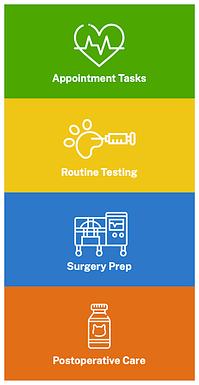By Katz, Sapper & Miller’s Veterinary Services Group
This article originally appeared on ksmcpa.com
Sooner or later, every veterinary practice will face staffing issues with doctors, technicians, assistants, and front office workers. Sadly, this scenario is more common than ever given today’s labor shortages. Whether you’re trying to staff up to meet higher demand or replace an associate who left your practice, here are three ways you can maximize your existing resources.
1) Lean on Your Technicians
Every member of a veterinary hospital is valuable to the team, but when your practice is short-staffed, veterinarians in particular can feel the pressure of trying to keep up. Our advice: max out your vet techs’ skills to free up your schedule as much as possible. Working within their scope of practice, vet techs can take vital signs and medical histories, collect specimens, provide first aid, prep for surgery, and so much more. In fact, the majority of a client’s appointment can be completed by a vet tech before a doctor even steps in the room. Maximize tech help by making a checklist for standard wellness exams and common medical conditions. Then, make sure the techs are well-equipped to greet clients, handle initial exams, and document medical histories. Routine tasks like ear swabs, fecal collections, blood draws, routine vaccines, and nail trimming can all be done by appropriately trained support staff. After consulting with the tech, the doctor can perform an exam, address any concerns that may arise, and prescribe treatments. For inpatient treatments like surgeries, doctors can also delegate operating room prep to qualified staff. Techs can even handle post-surgery tasks like delivering lab results, answering basic pet care questions, and giving postoperative pain management and basic take-home instructions. Complicated matters can and should be handled by the doctor as needed, but a competent tech can handle a wide variety of tasks and ease the workload. 
When your hospital is fully staffed, you may not feel pressure to invest time and money into automating your current systems. But add the pressure of being short-staffed, and streamlining processes can be a big timesaver. We all know that time is money, so automating is just as important as delegating. Depending on the software capabilities, you can leverage new technology to do a variety of tasks, including the following:
•Simplify payment processing
• Send appointment and vaccine reminders
• Offer online appointment booking
• Manage inventory more efficiently
• Provide self check-in via phone or kiosk
• Streamline prescription fulfillment
Thriving veterinary practices usually have jam-packed schedules. They want to be accommodating and take great care of their clients. And, of course, booking appointments is the bread and butter of any practice. But all too often, crammed schedules can become a burden on everyone involved. One way to mitigate strained schedules is to consider establishing predetermined time blocks based on the appointment type. Consider the appointment type needed and schedule an appropriate amount of time for that specific service. For example, wellness exams may need 20 minutes, vaccinations just 15 minutes, and sick visits 40 minutes. Make a list of common appointment types and procedures and train your team to schedule accordingly. Emergencies can quickly pack any veterinarian’s schedule. While some scenarios are truly urgent, other concerns can be safely addressed the following day. The trouble is knowing the difference between a true emergency versus an overly worried pet owner. Start by training your front office staff or vet techs on how to properly assess and triage a pet’s needs. Provide a checklist of questions to ask to help objectively gauge the situation. And if your clinic sees a lot of actual emergencies on a regular basis, make sure you’re leaving appropriate wiggle room in your daily schedule to allow for these urgent requests. Although managing a practice short on staff can be stressful, it’s important to keep a positive attitude moving forward and take steps to ease the load. Don’t be shy about leaning on your vet techs for support. And if your office staff is weighed down with tasks that can be automated, it may be time for a software upgrade to free up manpower and increase efficiency. Sometimes a few tweaks can make all the difference.
Learn more about KSM’s Veterinary Consulting


